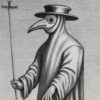FFS: Primary Stabbing (Ice Pick)
Primary stabbing headache (also known as ice pick headache, idiopathic stabbing headache) is characterised by ultra-brief, stabbing or electric shock-like pains that occur in the absence of structural disease.
Pains may occur in both trigeminal and extra-trigeminal regions, helping to distinguish it from trigeminal neuralgia.
Imaging is necessary to exclude structural abnormalities, especially if symptoms are consistently unilateral or localised to one site.
Most cases are brief and infrequent, and do not require treatment.
Persistent cases may respond to indomethacin.
History
First described by American ophthalmologist Richard K.Lansche in 1964 as ‘ophthalmodynia
periodica’. Further defined as “icepick-like pain” by Raskin and Schwartz in 1980.
Included as a separate entity in the classification of the International Headache Society (IHS) in 1988
- Severe, brief stabbing pain
- Often unilateral
- Typically in temporal or orbital distribution
Also referred to as:
- Ophthalmodynia periodica
- Jabs and jolts syndrome
Epidemiology
- Uncommon
- Affects both children and adults
Pathophysiology
- No identifiable structural abnormality
- Often coexists with migraine or cluster headache
- May represent spontaneous firing in sensitised individual nerve fibres
Clinical Features
| Feature | Description |
|---|---|
| Nature | Sharp, electric, stabbing; mild to severe |
| Duration | Ultra-brief, lasting seconds |
| Pattern | Single stabs or volleys over 1–15 minutes; median episode duration ~2 weeks; recurrences up to 2 years |
| Distribution | Anywhere in the head; both trigeminal and extra-trigeminal; location may vary |
| Associated Features | Wincing common; no cranial autonomic symptoms (helps distinguish from TACs); often coexists with other primary headaches |
Investigations
Recommended to exclude other causes when:
- Pain is strictly unilateral
- Pain is invariably localised
Imaging
- CT: Initial screening
- MRI: Preferred modality to exclude:
- Structural lesions (e.g. malignancy)
- Demyelinating disease
Management
No treatment required if attacks are infrequent and brief.
Persistent cases may benefit from:
| Therapy | Notes |
|---|---|
| Indomethacin | 75–150 mg daily – first-line |
| COX-2 NSAIDs | Alternative if GI side effects a concern |
| Melatonin | 3–12 mg daily |
| Gabapentin | 400 mg BD |
Disposition
Refer to Neurologist for assessment and confirmation of diagnosis
References
Publications
- Lansche RK. Ophtalmodynia periodica. Headache 1964; 4:247–9
- Raskin NH, Schwartz RK. Icepick-like pain. Neurology. 1980 Feb;30(2):203-5.
- Classification and diagnostic criteria for headache disorders, cranial neuralgias and facial pain. Headache Classification Committee of the International Headache Society. Cephalalgia. 1988;8 Suppl 7:1-96.
- França MC Jr, Costa AL, Maciel JA Jr. Gabapentin-responsive idiopathic stabbing headache. Cephalalgia. 2004 Nov;24(11):993-6.
- Brazis PW, Masdeu JC, Biller J. Localization in Clinical Neurology. 8e 2021
- Fuller G. Neurological Examination Made Easy. 6e 2019
FOAMed
- Coni R. Other primary headaches. LITFL
- Coni R. Headache classification. LITFL
- Coni R. Headache Essentials. LITFL
Fellowship Notes
MBBS DDU (Emergency) CCPU. Adult/Paediatric Emergency Medicine Advanced Trainee in Melbourne, Australia. Special interests in diagnostic and procedural ultrasound, medical education, and ECG interpretation. Co-creator of the LITFL ECG Library. Twitter: @rob_buttner
Educator, magister, munus exemplar, dicata in agro subitis medicina et discrimine cura | FFS |


